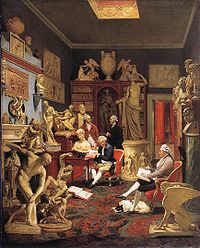- Clytie (Oceanid)
-
 Bust of Clytie, by Hiram Powers, modeled 1865-1867, carved 1873.
Bust of Clytie, by Hiram Powers, modeled 1865-1867, carved 1873.
Clytia (or Clytie) was a water nymph, daughter of Oceanus and Tethys in Greek mythology.[1] She loved Apollo.[2]
Contents
Narrative
Apollo, whom Clytie always loved, did not love her in return, for he loved Daphne, the daughter of a water god. Sadly, Daphne had no feelings toward the beautiful Apollo, and when Apollo tried to convince Daphne to love him in return, she ran from him, and began to beg for her father's help. Her father helped her by turning her into a plant. To Clytie, this was great, but to Apollo, the love of his life had just died. Clytie soon began to realized that Apollo still didn't love her, and went into deep sorrow. She stripped herself and sat naked, with neither food nor drink, for nine days on the rocks, staring at the sun, Apollo, and mourning his departure. After nine days she was transformed by the Gods into a beautiful turnsole (which is known for growing on sunny, rocky hillsides), which turns its head always to look longingly at Apollo's chariot of the sun.
Modern traditions substitude the turnsole with a sunflower, that is also known for turning in the direction of the sun. Sunflowers originate in North America and did not grow anywhere in the ancient old world.
Art
Bust (Townley collection)
One sculpture of Clytie is a Roman marble in the collection of Charles Townley.[3]
The bust was created between 40 and 50 AD. Towneley acquired it from the family of the principe Laurenzano in Naples during his extended second Grand Tour of Italy (1771–1774); the Laurenzano insisted it had been found locally. It remained a favorite both with him (it figures prominently in Johann Zoffany's iconic painting of Townley's library (illustration, right), was one of three ancient marbles Townley had reproduced on his visiting card, and was apocryphally the one which he wished he could carry with him when his house was torched in the Gordon Riots - apocryphal since the bust is in fact far too heavy for that) and with the public (Joseph Nollekens is said to have always had a marble copy of it in stock for his customers to purchase, and in the late 19th century Parian ware copies were all the rage.[4]
The identity of the subject, a woman emerging from a calyx of leaves, was much discussed among the antiquaries in Townley's circle. At first referred to as Agrippina, and later called by Townley Isis in a lotus flower, it is now accepted as Clytie. Some modern scholars even claim the bust is of eighteenth century date, though most now think it is an ancient work showing Antonia Minor or a contemporaneous Roman lady in the guise of Ariadne.
Bust (George Frederick Watts)
Another famous bust of Clytie was by George Frederick Watts.[5] Instead of Townley's serene Clytie, Watts's is straining, looking round at the sun.
References
- ^ Her name appears in the long list of Oceanids in Hesiod, Theogony 346ff.
- ^ Two other minor personages name Clytie are noted: see Theoi Project: Clytie.
- ^ Trustees of the British Museum - Marble bust of 'Clytie'
- ^ Trustees of the British Museum - Parian bust of Clytie
- ^ The Victorian Web - Clytie George Frederick Watts, R.A., 1817-1904
Categories:- Greek mythology
- Nymphs
- Townley collection
Wikimedia Foundation. 2010.


